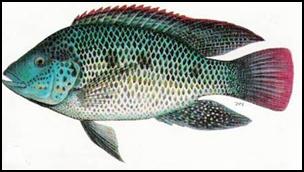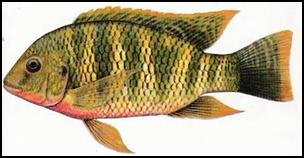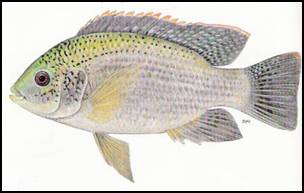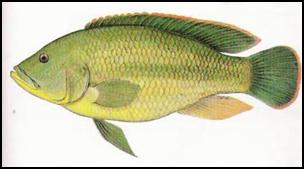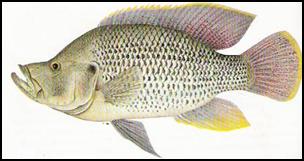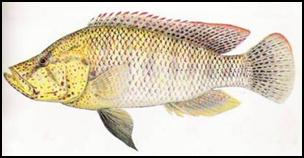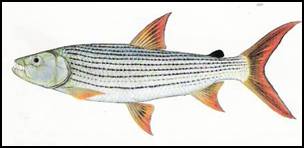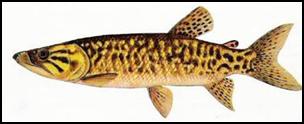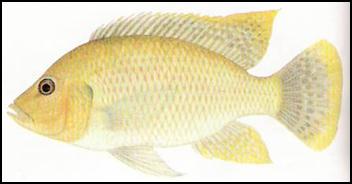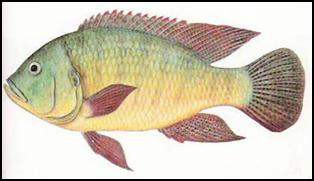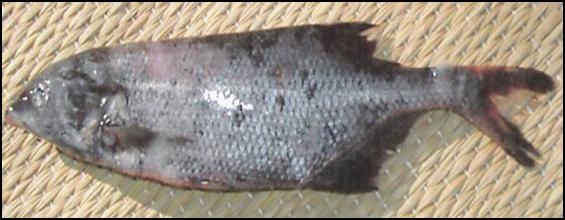MAIN ANGLING SPECIES OF THE UPPER ZAMBEZI
The Zambezi River is host to 134 recorded species of fish of which 96 species inhabit the Upper Zambezi. The main angling species of this section of the Zambezi River which are much sought after by anglers visiting Island View Lodge are:
(a)Threespot Tilapia:Oreochromis andersonii
Best Angling Period: June to December.
Angling Methods: A number 12 long shank barbed hook baited with red (kariba) live earthworms (available at the Lodge) fished on the riverbed is probably the most successful method of capturing this species. However the Threespot is also partial to spinners retrieved slowly on the river bottom. Occasionally also caught on small spoons and lures whilst angling for other species.
Recommended Bait/Lures: Earthworms, Mepps Black Fury No 4 spinners and Blue Fox Vibrax No 3 spinners.
Size and Fighting Ability: Attains a TL of about 450mm, about 3.2 kilograms. Island View Lodge record is 4.2 kilograms.
Fights deep always seeking hidden structure and will test the anglers skill to the limit.
Other: Valued in Aquaculture. Very good table fish. Mouth brooder which lives 7 to 8 years.
(be)Redbreast Tilapia: Tilapia rendalli
Best Angling Period: July to December.
Angling Methods: Same as Threespot Tilapia but differs in habitat as it prefers shallower well vegetated bays and backwaters as apposed to deep bays and channels.
Recommended Bait/Lures: Same as for Threespot Tilapia.
Size and Fighting Ability: Attains about 400mm TL, 2.0 kilograms. Island View Lodge record is 2.4 kilograms. A worthy adversary which is adept at using structure to itís advantage.
Other: A good table fish. Valued in aquaculture. Used for weed control in many dams. Lives up to 7 years.
(c)Greenhead Tilapia: Oreochromis macrochir
Best Angling Period: July to December.
Angling Methods: This species is very seldom captured on artificial lures as it feeds mainly on microscopic foods such as algae and diatoms. A no 10 long shank hook baited with red earthworms fished on the bottom near structure such as dead trees or bushes is the most successful method of capturing this species.
Recommended Bait: Red (kariba) worms.
Size and Fighting Ability: Attains a TL of 380-400mm. Specimens of up to 3 kilograms are captured from time to time in gill nets of local fisherman. Gives a very good account of itself on light angling tackle. Island View Lodge record 2.6 kilograms.
Other: Females mouthbrood eggs, larvae and small fry. Lacks firmness of flesh to be recommended as a good table fish.
(d)Nembwe:Serranochromis robustus
Best Angling Periods: Late May to December but more active in the Winter months preferring cooler water temperatures.
Angling Methods: Although the Nembwe will readily take worms or live bait it is very much a predator and therefore artificial baits are recommended. Trolling the deep channels or spinning the shoreline structure are the most successful means of capture.
Recommended Baits: A variety of artificial baits can be used but experience has proved that the Rapala 5cm Fat Rap deep diver, Rapala 5 or 7cm Shad Rap deep diver, the Cordell 5cm Wally Diver or leadhead jigs are probably the most successful lures for the capture of these aggressive predators. Spinnerbaits, copper or chrome Effzett 16 gram spoons, Mepps No 4 Black Fury spinners and Blue Fox No 3 Vibrax spinners are also readily taken by Nembwe.
Size and Fighting Ability: Attains about 450mm, about 3.5kg but one specimen was reported to weigh in at 6.123kg. Island View Lodge record stands at 3.300kg. The Nembwe is famous for its aggressiveness
hence itís scientific specie name of robustus.
Other: Excellent table fish with firm white flesh.Valuable commercial and subsistence fishery species. Also known as the Yellow-belly bream or Robbie.
(e)Humpback Largemouth: Serranochromis altus
(f)Thinface Largemouth: Serranochromis angusticeps
(e)
(f)
Best Angling Period: August to December but most active August to early November.
Angling Methods: Same as for (d) Nembwe.
Recommended Bait: Same as for (d) Nembwe.
Size and Fighting Abilities: Both attain a standard length of about 410mm. Island View Lodge record for the Thinface Largemouth is 3.80kg and the Humpback Largemouth is 3.50kg. Both these species are worthy adversaries when hooked and give a good account of themselves.
The Thinface Largemouth will often leap bass-like out of the water in an attempt to rid itself of the artificial bait.
Other: Both fine table fish and important commercial and subsistence fish species. Until fairly recently the Thinface and Humpback Largemouths were considered to be a single species. Both live between 7 and 9 years.
(g)Tigerfish: Hydrocynus vittatus
Best Angling Periods: Although Tigerfish can be caught throughout the year on the Upper Zambezi River much is dependent on the river water levels which is determined by the extent of the rainfall in the catchment areas. Under normal rainfall conditions peak fishing periods for this species is early April to end January.
Angling Methods: The Tigerfish is a fierce aggressive predator with razor sharp teeth which can be captured by trolling artificial baits, spin casting artificial baits and drifting a fresh dead fish afixed to a hook or drifting a live fish afixed to a hook.Tigerfish have a preference for deep fast flowing channels where they lurk in drop-offs in readiness to ambush their prey. Prey of up to 40% or more of the size of the attacking Tigerfish are taken from the side and then swallowed whole usually head first.
Recommended Baits: Various artificial baits can be used but from experience the following have proved the most successful: Rapala 9 or 11cm Magnum floating lures (trolling), chrome or copper 45mm, 16 gram Effzett spoons (trolling and spincasting) and Rapala 7cm Fat Rap or Shadrap deep diver lures (spincasting). The Tigerfish has a preference for driftbait and live bait at certain times of the year especially when water levels are at a peak and the water is slightly discoloured or murky. The Bulldog (Marcusenius macrolepidotus) which is a small fish obtained from local gillnet fishermen is an ideal drift bait as it is favoured by Tigerfish.
Size and Fighting Abilities: The Tigerfish is probably one of the most spectacular and aggressive freshwater game fish any angler could wish to encounter. Its powerful strike, steamtrain runs and spectacular aerial leaps make it a truly worthy adversary sought after by anglers from far and wide. Island View Lodge angling record is 8.800kg. Males attain a 500mm fork length whilst females grow to above 700mm fork length. Female Lake Tiger grow to bigger sizes than their more slender and aggressive river Tiger counterparts.
Other: Not a recommended table fish. Does not breed in captivity. Females live up to 9 years.
(h)African Pike: Hepsetus Odoe
Best Angling Period: July to Late December.
Angling Methods: Prefers quiet deep backwaters and floodplain lagoons (molapos). Not usually found with Tigerfish as their habitat and hunting strategies differ. A top predator, the African Pike stalks and ambushes prey with a swift sudden rush. Spin casting with small spinners is the ideal method of capturing these ferocious water torpedos.
Recommended Bait: Mepps Black Fury No1 or No2 spinners or any similar small spinners attached to light line on a light spinning rod.
Size and Fighting Abilities: Attains 470mm fork length, about 2kg.
The African Pike is not unlike the Tigerfish when hooked, performing spectacular aerial leaps in an endevour to dislodge the bait.
Other: Not a recommended table fish. Relatively short-lived, only 4-5 years. Island View Lodge record 1.3 kilograms.
(i)Sharptooth Catfish: Clarias gariepinus.
Best Angling Periods: Can be caught throughout the year but more active from May to December.
Angling Methods: The Sharptooth Catfish is completely omnivorous Ė preys and scavenges on virtually any available food source including fish, birds, frogs, small mammals, reptiles, snails, crabs, shrimps and insects. Although this species will readily take lures, spoons or spinners it is more often caught by using bait on a size 3/0 or 4/0 hook fished on the bottom.
Recommended Bait: Favours bait such as ox-heart, chicken livers, day old chicks, baby birds, fish fillets and earthworms. Not caught on any specific lure or artificial bait but is usually taken on artificial bait whilst angling for other species ie. Tigerfish or Nembwe.
Large Catfish put up an incredible fight, staying deep and continuously shaking their heads from side to side in an attempt to dislodge the hook. Most large Catfish hooked from the shore break free on the initial run or strip the reel of all line leaving a bewildered angler floundering in his misfortune.
Other: Attains a standard length of 1.4 meters, about 54kg. Island View Lodge record is 24.6kg. Specimens in excess of 30kg have been caught but not weighed on an official electronic scale. Not a recommended table fish but relished by local villagers. It is preyed on by crocodiles, Fish Eagles and Marabou Storks. Lives to about 9-10 yrs.
(j)Green Bream: Sargochromis codringtonii.
(k)Pink Bream: Sargochromis giardi.
(j)
(k)
Best Angling Periods: July to December.
Angling Methods: More often caught on earthworm fished on the bottom than any other method. However both species will take spinners and lures up to 5cm. The Green Bream prefers deep quiet waters, slow flowing channels and floodplain lagoons whereas the Pink Bream inhabits deep main river channels and sandy bays.
Recommended Bait: Red earthworms (Kariba) on a No12 long shank barbed hook. Also taken on Mepps No3 Black Fury spinners or 5cm Rapala Fat Rap deep divers.
Fighting Abilities: The Pink Bream attains a total length of 480mm and the Green Bream a total length of 300mm.
Island View Records for the Pink Bream is 3,05kg (an all-Africa Record) and the Green Bream is 2,5kg.
Both the species are very robust fighters when hooked and many anglers have had their skills tested to the limit.
Other: Both are excellent table fish. Besides an important subsistence and commercial value they are also a useful snail control agent. Both species live up to 6-7 years.
Driftbait: Bulldog: Marcusenius macrolepidotus
Compiled by Garth Cavanagh - Shamwari Houseboat Safaris [copyright on text and photos]
The Zambezi River is host to 134 recorded species of fish of which 96 species inhabit the Upper Zambezi. The main angling species of this section of the Zambezi River which are much sought after by anglers visiting Island View Lodge are:
(a)Threespot Tilapia:Oreochromis andersonii
Best Angling Period: June to December.
Angling Methods: A number 12 long shank barbed hook baited with red (kariba) live earthworms (available at the Lodge) fished on the riverbed is probably the most successful method of capturing this species. However the Threespot is also partial to spinners retrieved slowly on the river bottom. Occasionally also caught on small spoons and lures whilst angling for other species.
Recommended Bait/Lures: Earthworms, Mepps Black Fury No 4 spinners and Blue Fox Vibrax No 3 spinners.
Size and Fighting Ability: Attains a TL of about 450mm, about 3.2 kilograms. Island View Lodge record is 4.2 kilograms.
Fights deep always seeking hidden structure and will test the anglers skill to the limit.
Other: Valued in Aquaculture. Very good table fish. Mouth brooder which lives 7 to 8 years.
(be)Redbreast Tilapia: Tilapia rendalli
Best Angling Period: July to December.
Angling Methods: Same as Threespot Tilapia but differs in habitat as it prefers shallower well vegetated bays and backwaters as apposed to deep bays and channels.
Recommended Bait/Lures: Same as for Threespot Tilapia.
Size and Fighting Ability: Attains about 400mm TL, 2.0 kilograms. Island View Lodge record is 2.4 kilograms. A worthy adversary which is adept at using structure to itís advantage.
Other: A good table fish. Valued in aquaculture. Used for weed control in many dams. Lives up to 7 years.
(c)Greenhead Tilapia: Oreochromis macrochir
Best Angling Period: July to December.
Angling Methods: This species is very seldom captured on artificial lures as it feeds mainly on microscopic foods such as algae and diatoms. A no 10 long shank hook baited with red earthworms fished on the bottom near structure such as dead trees or bushes is the most successful method of capturing this species.
Recommended Bait: Red (kariba) worms.
Size and Fighting Ability: Attains a TL of 380-400mm. Specimens of up to 3 kilograms are captured from time to time in gill nets of local fisherman. Gives a very good account of itself on light angling tackle. Island View Lodge record 2.6 kilograms.
Other: Females mouthbrood eggs, larvae and small fry. Lacks firmness of flesh to be recommended as a good table fish.
(d)Nembwe:Serranochromis robustus
Best Angling Periods: Late May to December but more active in the Winter months preferring cooler water temperatures.
Angling Methods: Although the Nembwe will readily take worms or live bait it is very much a predator and therefore artificial baits are recommended. Trolling the deep channels or spinning the shoreline structure are the most successful means of capture.
Recommended Baits: A variety of artificial baits can be used but experience has proved that the Rapala 5cm Fat Rap deep diver, Rapala 5 or 7cm Shad Rap deep diver, the Cordell 5cm Wally Diver or leadhead jigs are probably the most successful lures for the capture of these aggressive predators. Spinnerbaits, copper or chrome Effzett 16 gram spoons, Mepps No 4 Black Fury spinners and Blue Fox No 3 Vibrax spinners are also readily taken by Nembwe.
Size and Fighting Ability: Attains about 450mm, about 3.5kg but one specimen was reported to weigh in at 6.123kg. Island View Lodge record stands at 3.300kg. The Nembwe is famous for its aggressiveness
hence itís scientific specie name of robustus.
Other: Excellent table fish with firm white flesh.Valuable commercial and subsistence fishery species. Also known as the Yellow-belly bream or Robbie.
(e)Humpback Largemouth: Serranochromis altus
(f)Thinface Largemouth: Serranochromis angusticeps
(e)
(f)
Best Angling Period: August to December but most active August to early November.
Angling Methods: Same as for (d) Nembwe.
Recommended Bait: Same as for (d) Nembwe.
Size and Fighting Abilities: Both attain a standard length of about 410mm. Island View Lodge record for the Thinface Largemouth is 3.80kg and the Humpback Largemouth is 3.50kg. Both these species are worthy adversaries when hooked and give a good account of themselves.
The Thinface Largemouth will often leap bass-like out of the water in an attempt to rid itself of the artificial bait.
Other: Both fine table fish and important commercial and subsistence fish species. Until fairly recently the Thinface and Humpback Largemouths were considered to be a single species. Both live between 7 and 9 years.
(g)Tigerfish: Hydrocynus vittatus
Best Angling Periods: Although Tigerfish can be caught throughout the year on the Upper Zambezi River much is dependent on the river water levels which is determined by the extent of the rainfall in the catchment areas. Under normal rainfall conditions peak fishing periods for this species is early April to end January.
Angling Methods: The Tigerfish is a fierce aggressive predator with razor sharp teeth which can be captured by trolling artificial baits, spin casting artificial baits and drifting a fresh dead fish afixed to a hook or drifting a live fish afixed to a hook.Tigerfish have a preference for deep fast flowing channels where they lurk in drop-offs in readiness to ambush their prey. Prey of up to 40% or more of the size of the attacking Tigerfish are taken from the side and then swallowed whole usually head first.
Recommended Baits: Various artificial baits can be used but from experience the following have proved the most successful: Rapala 9 or 11cm Magnum floating lures (trolling), chrome or copper 45mm, 16 gram Effzett spoons (trolling and spincasting) and Rapala 7cm Fat Rap or Shadrap deep diver lures (spincasting). The Tigerfish has a preference for driftbait and live bait at certain times of the year especially when water levels are at a peak and the water is slightly discoloured or murky. The Bulldog (Marcusenius macrolepidotus) which is a small fish obtained from local gillnet fishermen is an ideal drift bait as it is favoured by Tigerfish.
Size and Fighting Abilities: The Tigerfish is probably one of the most spectacular and aggressive freshwater game fish any angler could wish to encounter. Its powerful strike, steamtrain runs and spectacular aerial leaps make it a truly worthy adversary sought after by anglers from far and wide. Island View Lodge angling record is 8.800kg. Males attain a 500mm fork length whilst females grow to above 700mm fork length. Female Lake Tiger grow to bigger sizes than their more slender and aggressive river Tiger counterparts.
Other: Not a recommended table fish. Does not breed in captivity. Females live up to 9 years.
(h)African Pike: Hepsetus Odoe
Best Angling Period: July to Late December.
Angling Methods: Prefers quiet deep backwaters and floodplain lagoons (molapos). Not usually found with Tigerfish as their habitat and hunting strategies differ. A top predator, the African Pike stalks and ambushes prey with a swift sudden rush. Spin casting with small spinners is the ideal method of capturing these ferocious water torpedos.
Recommended Bait: Mepps Black Fury No1 or No2 spinners or any similar small spinners attached to light line on a light spinning rod.
Size and Fighting Abilities: Attains 470mm fork length, about 2kg.
The African Pike is not unlike the Tigerfish when hooked, performing spectacular aerial leaps in an endevour to dislodge the bait.
Other: Not a recommended table fish. Relatively short-lived, only 4-5 years. Island View Lodge record 1.3 kilograms.
(i)Sharptooth Catfish: Clarias gariepinus.
Best Angling Periods: Can be caught throughout the year but more active from May to December.
Angling Methods: The Sharptooth Catfish is completely omnivorous Ė preys and scavenges on virtually any available food source including fish, birds, frogs, small mammals, reptiles, snails, crabs, shrimps and insects. Although this species will readily take lures, spoons or spinners it is more often caught by using bait on a size 3/0 or 4/0 hook fished on the bottom.
Recommended Bait: Favours bait such as ox-heart, chicken livers, day old chicks, baby birds, fish fillets and earthworms. Not caught on any specific lure or artificial bait but is usually taken on artificial bait whilst angling for other species ie. Tigerfish or Nembwe.
Large Catfish put up an incredible fight, staying deep and continuously shaking their heads from side to side in an attempt to dislodge the hook. Most large Catfish hooked from the shore break free on the initial run or strip the reel of all line leaving a bewildered angler floundering in his misfortune.
Other: Attains a standard length of 1.4 meters, about 54kg. Island View Lodge record is 24.6kg. Specimens in excess of 30kg have been caught but not weighed on an official electronic scale. Not a recommended table fish but relished by local villagers. It is preyed on by crocodiles, Fish Eagles and Marabou Storks. Lives to about 9-10 yrs.
(j)Green Bream: Sargochromis codringtonii.
(k)Pink Bream: Sargochromis giardi.
(j)
(k)
Best Angling Periods: July to December.
Angling Methods: More often caught on earthworm fished on the bottom than any other method. However both species will take spinners and lures up to 5cm. The Green Bream prefers deep quiet waters, slow flowing channels and floodplain lagoons whereas the Pink Bream inhabits deep main river channels and sandy bays.
Recommended Bait: Red earthworms (Kariba) on a No12 long shank barbed hook. Also taken on Mepps No3 Black Fury spinners or 5cm Rapala Fat Rap deep divers.
Fighting Abilities: The Pink Bream attains a total length of 480mm and the Green Bream a total length of 300mm.
Island View Records for the Pink Bream is 3,05kg (an all-Africa Record) and the Green Bream is 2,5kg.
Both the species are very robust fighters when hooked and many anglers have had their skills tested to the limit.
Other: Both are excellent table fish. Besides an important subsistence and commercial value they are also a useful snail control agent. Both species live up to 6-7 years.
Driftbait: Bulldog: Marcusenius macrolepidotus
Compiled by Garth Cavanagh - Shamwari Houseboat Safaris [copyright on text and photos]
